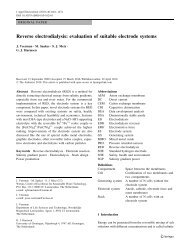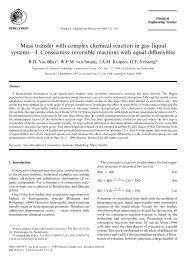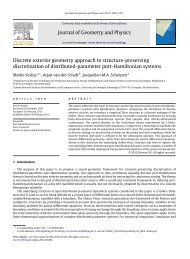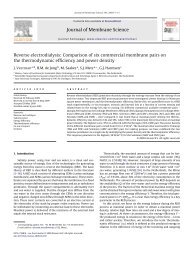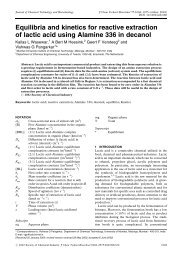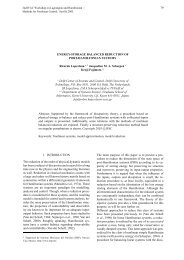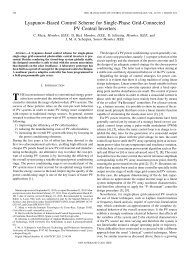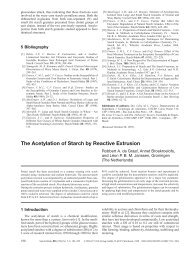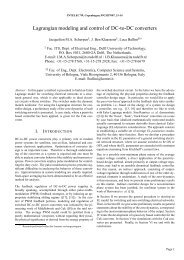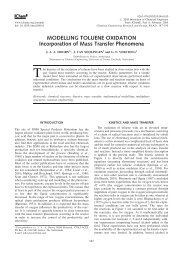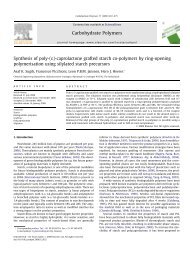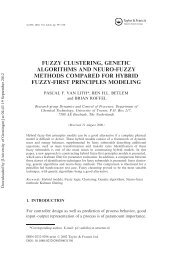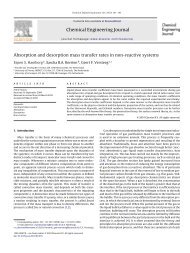Mass transfer with complex chemical reaction in gas—liquid ... - ITM
Mass transfer with complex chemical reaction in gas—liquid ... - ITM
Mass transfer with complex chemical reaction in gas—liquid ... - ITM
- No tags were found...
You also want an ePaper? Increase the reach of your titles
YUMPU automatically turns print PDFs into web optimized ePapers that Google loves.
138 R.D. Vas Bhat et al./Chemical Eng<strong>in</strong>eer<strong>in</strong>g Science 54 (1999) 137—147Table 1Program <strong>in</strong>put parametersVariable Value UnitsA 10 mol mB 40 mol mk 10—10 msk 0.25—2.610 m mol sK 0.01—100 —K 0.01—100 —K 10—10 —α 10 —D 10 m svariables used <strong>in</strong> the simulations presented <strong>in</strong> this workare given <strong>in</strong> Table 1.In order to ma<strong>in</strong>ta<strong>in</strong> brevity, Part II deals <strong>with</strong> theeffect of a change <strong>in</strong> diffusivity only for the case whereboth <strong>reaction</strong>s (1b) and (1c) are reversible, as it is for thiscase that maximum deviations from the equal diffusivitysituation are observed. S<strong>in</strong>ce this paper aims to understandthe <strong>in</strong>fluence of species diffusivities on the overallmass <strong>transfer</strong> phenomenon, the diffusivity ratios havebeen varied between exaggerated extremes to magnifythese effects. Consequently, these values of diffusion coefficientsshould not be expected to occur <strong>in</strong> real systems,though the effects that they produce may be observed <strong>in</strong>reality.2. Influence of species diffusivityDiffusivity of each <strong>chemical</strong> species has been varied<strong>in</strong>dividually. Results have been presented as a functionof the diffusivity ratio of the species concerned,def<strong>in</strong>ed asr " D D (3)where D is the diffusion coefficient of species ‘i’.2.1. Diffusivity of AOn account of the vast range of calculations possible,only some significant phenomena and/or non-trivial resultshave been elucidated here.The effect of a change <strong>in</strong> the diffusivity of A on themass <strong>transfer</strong> behaviour is shown <strong>in</strong> Fig. 1 where r isvaried between two extreme ratios of 0.1—10 (K "10;K "100). In general, a higher enhancement is observedfor a lower mobility of A. This stems from the fact that,a lower mobility of the gaseous species results <strong>in</strong> a greaterconcentration gradient near the <strong>gas—liquid</strong> <strong>in</strong>terface and,consequently, a higher driv<strong>in</strong>g force. There is a two-step<strong>in</strong>crease <strong>in</strong> the enhancement similar to that observed <strong>in</strong>the case of equal diffusivities. The <strong>in</strong>termediate asymptoticenhancement factor (E ) can be calculated fromstandard methods such as the one presented by DeCourseyand Thr<strong>in</strong>g (1989).2.1.1. Effect of K The effect of K on the mass <strong>transfer</strong> behaviour isobserved <strong>in</strong> Fig. 2(a) and (b) for r "10 and 0.1, respectively(K "100; K "10). As is seen for reversible<strong>reaction</strong>s <strong>with</strong> equal diffusivities, the values of the <strong>in</strong>termediate(E ) and f<strong>in</strong>al enhancement factors (E ) <strong>in</strong>crease<strong>with</strong> K .However, <strong>in</strong> case of a low mobility of A [Fig. 2(b)],some peculiar, not a priori expected, effects are observedfor the case of high K values (typically K "10—100). InFig. 1. Effect of diffusivity of A on enhancement.



